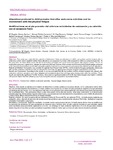Modificaciones en el pie pronador del niño tras actividades de resistencia y su relación con el cansancio físico

View/
Use this link to cite
http://hdl.handle.net/2183/17615Collections
Metadata
Show full item recordTitle
Modificaciones en el pie pronador del niño tras actividades de resistencia y su relación con el cansancio físicoAlternative Title(s)
Alterations produced in child pronator foot after endurance activities and its involvement with the physical fatigueAuthor(s)
Date
2015Citation
European Journal of Podiatry 2015, 1: 1-7 ISSN: 2445-1835
Abstract
[Resumen] Objetivos: Este estudio se plantea con el objetivo de determinar si existen cambios en la postura del pie y en la huella plantar de los niños tras una actividad deportiva de resistencia y si estos cambios son mayores en los niños con pies pronadores respecto a los que presentan una tipología de pies neutros. A su vez relacionar todo esto con el cansancio físico desencadenado y los dolores musculares que aparecen tras la actividad física. Nos planteamos llevar a cabo este estudio con la idea de conocer, entre tanta controversia, si el pie pronador presenta algún tipo de desventaja respecto al pie neutro, y si precisaría por tanto de tratamiento ortopodológico como medida de prevención y mejora de las alteraciones biomecánicas en etapas infantiles.Material y Método: Se valoró la postura del pie mediante el Índice de Postura del Pie (en adelante FPI-6), y la huella plantar mediante una pedigrafía, antes y después de ejercicios de resistencia de tipo aeróbicos, para posteriormente calcular el Arch Index mediante el programa informático AutoCad® a cada huella.Resultados y conclusiones: Según los resultados, se puede concluir que la postura del pie y la huella plantar de los niños se modificó tras los ejercicios de resistencia, los pies pronadores se cansaron más y refirieron dolor en pies y piernas durante y/o post actividad, siendo estos resultados estadísticamente significativos (P<0.05). Sin embargo no hubo evidencia significativa (P>0.05) de que estos cambios fuesen mayores en los niños con pies pronadores ni que éstos rindieran menos que los niños con pies neutros durante la actividad. [Abstract] Objectives: This study was made with the objective of determine if there are alterations in child’s foot position and his footprint after a endurance activity and to establish wether these alterations are increased in pronator child compared to child who present neutral feet. At the same time, we relate all the above with the extreme physical fatigue and muscle aches that appear after physical activity. The aim of making this essay was to get to know, despite the controversy this topic arouses, if the pronator foot has some kind of disadvantage compared to the neutral foot and wheter it would need orthopedic podiatric treatment as a way to prevent and improve the child biomechanic alterations.Material and Method: Foot position was consider through the Foot Posture Index (FPI-6), and the footprint through a pedigraphy, before and after aerobic endurance activities in order to calculate the Arch Index by applying the computer program AutoCad® to every print.Results and Conclusions: According to the results, it can be concluded that the foot position and the children footprint was altered after endurance activities, pronators were more fatigated and complained about feet and legs aches during and/or after the activities. These results are statistically significant (P<0.05). However, there were no significant evidence (P>0.05) that these changes were higher in children with pronator feet or that their efficiency was lower during the exercise compared to neutral feet children
Keywords
Pie pronador
Actividades de resistencia
Cansancio físico
Dolor muscular
Niños
Pronated foot
Physical fatigue
Muscle aches
Children
Endurance activities
Actividades de resistencia
Cansancio físico
Dolor muscular
Niños
Pronated foot
Physical fatigue
Muscle aches
Children
Endurance activities
Editor version
ISSN
2445-1835





